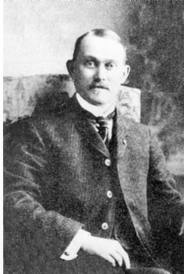Arthur Burnett Benton (Arthur Burnett Benton)

American Architect. In 1887, Benton studied at the Topeka School of Art and Design in Kansas. The following year he went to work for two years as a draftsman in the architectural department of the Atchison, Topeka and Santa Fe Railroad. In 1890, he relocated to Omaha, Nebraska, where he worked as a draftsman in the chief engineer’s office of the Union Pacific Railroad. The following year, he moved to Los Angeles and within two years, he went into an architectural partnership with William C. Aiken. For the next several years the firm of Aiken and Benton designed opulent residences, mostly in the Angeleno Heights section of town. By 1896, Benton bought out his partner’s interest and remained solo for the rest of his career. That year also marked the formation of the California Landmarks Club, which Charles F. Lummis founded to restore and preserve the old Spanish and Mexican Missions. Benton, along with Architect, Sumner Hunt, were among the original founders of the organization. Benton served as the club’s secretary and supervised the restorations of both the San Juan Capistrano and San Diego Missions. In 1900, he designed the First Church of Christian Science in Riverside which was built in the mission style. This building caught the eye of Frank Augustus Miller, who had a vision of a great mission style hotel and in 1902, work began on the first phase of the Mission Inn, under Benton’s supervision. Two major wings using different themes and different architects, one being Myron Hunt, were added in 1913 and 1930. At least three other major Hotels were part of his resume, The Mission Revival Hotel in Santa Barbara, the Arrowhead Hotel located in San Bernardino and the San Marcos Hotel in Chandler Arizona. Benton designed a number of Episcopal churches, including the All Saints at Duarte, All Saints by the Sea at Montecito, St. John the Evangelist in Chico, Trinity Episcopal Mission, at Port Hueneme, Holy Trinity in Covina, St. Marks in Upland and the Church of the Advent in Los Angeles. He also had a number of significant institutional commissions, including several for both the YMCA and the YWCA. His best-known and most lavish work in this area is his 1912 Mary Andrews Clark YWCA home in Los Angeles. In 1922, he designed the Mission Playhouse in San Gabriel. His last major work was the Riverside Municipal Auditorium, which was completed in 1927. Besides the Landmarks Club, he was also a founding member of the Southern California Chapter of the American Institute of Architects, for which he served as president several times, the Engineers and Architects Association of Southern California, which he also presided over and the Sons of the Revolution, for which he also served as president. (bio by: Louis M.)
Born
- April, 17, 1858
- USA
Died
- September, 09, 1927
- USA
Other
- Cremated

